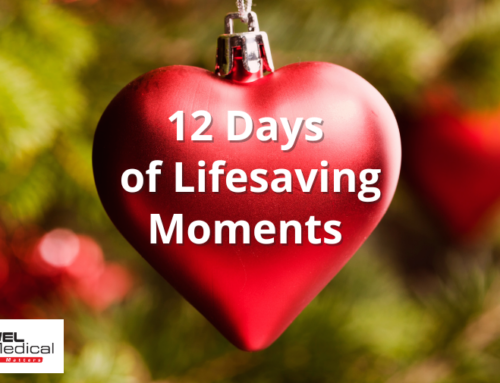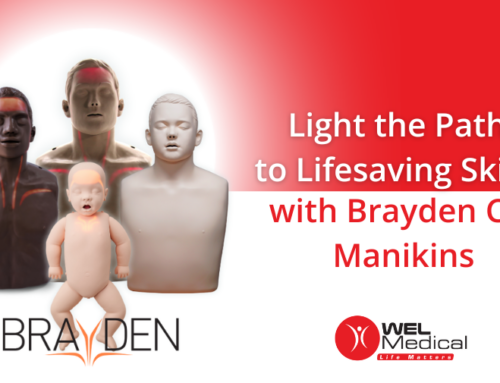[vc_row][vc_column][vc_column_text]A heart attack is the same as a cardiac arrest… right?
Wrong.
While people often use the terms interchangeably, they are in fact two separate conditions, with differing causes, symptoms, treatments and prognoses.
Ahead of World Heart Day on 29th September, we explain the difference between heart attacks and cardiac arrests and how to help someone experiencing either condition.
What exactly happens during a heart attack?
[/vc_column_text][vc_empty_space height=”16px”][vc_single_image image=”2400″ img_size=”full”][/vc_column][/vc_row][vc_row][vc_column][vc_empty_space height=”36px”][vc_column_text]
The cause
A heart attack is caused by a blockage/ clot, or narrowing (as with a condition like angina) in an artery that carries blood to and from the heart. This starves the heart of both blood and oxygen, causing that part of the heart to begin to die. The longer it lasts before medical intervention, the greater the damage.
The outward effect
The heart doesn’t stop beating during a heart attack. Instead, the casualty is likely to be awake while experiencing pain, light-headedness, breathlessness and sweating.
Immediate treatment
Because the patient will, in all likelihood, be awake and lucid during a heart attack, the most important thing is to call 999 and wait for an ambulance to arrive.
Medical professionals getting to you will take significantly less time than getting to a hospital yourself, and they will be trained to treat the condition on arrival before taking the casualty to the hospital for further care.
In the meantime, try to keep the casualty comfortable and as calm as possible – even allowing for the frightening circumstances.
[/vc_column_text][vc_empty_space height=”16px”][vc_row_inner][vc_column_inner][vc_column_text]
What happens to a person during a cardiac arrest?
[/vc_column_text][/vc_column_inner][/vc_row_inner][vc_empty_space height=”16px”][vc_single_image image=”2401″ img_size=”full”][vc_empty_space height=”16px”][/vc_column][/vc_row][vc_row][vc_column][vc_column_text]
The cause
As mentioned in our blog post ‘What Happens When You Use A Defibrillator?’, a sudden cardiac arrest (SCA) is caused by a problem in the heart’s electrical system. This leads to an interruption to signals received by the heart’s sinoatrial node, the heart’s natural pacemaker. Unable to administer its usual methodical rhythm, the SA node instead sends the heart into a flutter or spasm; a condition called ventricular fibrillation.
The outward effect
The effect of this is that the casualty collapses to the floor, often with no visible signs of life. They become unresponsive, and are either breathing abnormally (often gasping) or, the majority of the time, are not breathing at all.
Immediate treatment
As with a heart attack, the first action to take when you see someone suffer an SCA is to call 999 and request an ambulance.
Next, have one person administer CPR while another person seeks out the nearest automated external defibrillator. (AED). Someone experiencing a cardiac arrest has a 10-minute window where this must be performed. Every minute that passes without CPR and defibrillation reduces their chances of survival by 10%.
CPR will keep the flow of blood moving around the casualty’s body and through the heart, while defibrillation is designed to shock the SA node into resetting. The two combined are absolutely crucial to the chances of the casualty surviving a sudden cardiac arrest.
Luckily, CPR is easy to administer, and modern AEDs are incredibly easy to operate. In fact, ones like our own iPAD SP1 even have a voiceover mode that will talk you through what to do at each stage.
For more on administering CPR effectively in line with current Covid-19 guidelines, see our post on ‘CPR Guidance in a Covid-19 World.’
Are the two conditions connected?
As you can see, the differences in terms of cause and symptoms between a heart attack versus cardiac arrest are stark. However, there is one main link between the two: the onset of a heart attack can sometimes trigger a sudden cardiac arrest.
If someone you know is experiencing a heart attack and suddenly falls unconscious, it would be wise to assume they have experienced a cardiac arrest and begin following the guidance above, starting with administering CPR.
Heart attack and sudden cardiac arrest differences at a glance
[/vc_column_text][/vc_column][/vc_row][vc_row][vc_column][vc_empty_space][vc_single_image image=”2402″ img_size=”full” alignment=”center”][vc_column_text]Image credit: British Heart Foundation[/vc_column_text][vc_empty_space][/vc_column][/vc_row][vc_row][vc_column][vc_column_text]Want an easy way to remember the differences between heart attack and cardiac arrest? This table should help!
| Heart attack | Cardiac arrest | |
| Cause | Clogged arteries. | Ventricular fibrillation. |
| Heart stops pumping? | No. | Yes. |
| Is the casualty conscious? | In all likelihood, yes. | No. |
| Symptoms | Pain, pressure or burning in the chest, often with dizziness, breathlessness and sweating. | Sudden collapse into unconsciousness and generally unresponsive, with abnormal breathing or a complete lack of breath altogether. |
| Action to take | Call 999, keep the casualty calm until help arrives. | Call 999, administer CPR and defibrillation until help arrives. |
| Chances of survival | At least 70% survival rate for those treated promptly and admitted to hospital for care. | Approx. 10% survival rate for those who suffer an out-of-hospital cardiac. |
So, what is worse, a heart attack or a cardiac arrest?
[/vc_column_text][/vc_column][/vc_row][vc_row][vc_column][vc_empty_space][vc_single_image image=”2403″ img_size=”full” alignment=”center”][vc_empty_space][/vc_column][/vc_row][vc_row][vc_column][vc_column_text]While both conditions are undoubtedly serious, and you should call 999 immediately for both, a sudden cardiac arrest is by far the more urgent of the two. While a heart attack can go unnoticed and build over a long time, a cardiac arrest is instantaneous. Once it happens, you literally have 10 minutes with an SCA to administer CPR and defibrillation in order to save someone’s life. So, the earlier you start administering urgent CPR and defibrillation, the better their chances of survival will be.
There are also big differences in the ongoing prognoses for each condition:
- With immediate treatment, the chances of surviving a heart attack are good, with at least seven in 10 people surviving a heart attack, according to the British Heart Foundation. Recovery usually means a stay in hospital, and some lifestyle adjustments afterwards. However, the overall prognosis is good for a full and happy life in the mid to long term if those healthy changes are observed. See the British Heart Foundation’s heart attack page for more information.
- By contrast, the chances of someone surviving an out of hospital cardiac arrest are just one in 10. Recovery for those fortunate few often involves the fitting of an internal defibrillator in order to address the underlying medical condition that caused the SCA in the first place. Like a heart attack, lifestyle changes will be suggested, though the lack of oxygen to the brain during the cardiac arrest can also have longer-term implications like personality changes, memory problems, and more. The British Heart Foundation’s page on cardiac arrests offers more details, including information on emotional support and caring for someone who’s had a cardiac arrest.
Helping to treat sudden cardiac arrests
At WEL Medical, our products and services are designed to treat sudden cardiac arrests. We’re the leading supplier of defibrillators in the UK, and also offer a vast range of cabinets and cases, CPR manikins and more – alongside full training on how to use them.
Want to be ready to save lives but not sure where to get started? Please get in touch – we’ll be happy to help.
Related articles
- What Happens When You Use A Defibrillator?
- World First Aid Day: CPR Guidance in a Covid-19 World
- Places You Wouldn’t Think Need a Defib (But Really Do!)
- Soccer Shock: Why Football Needs Defibrillators at Every Level
- WEL Medical and Premier League Team Up for Lifesaving Grassroots Defibrillation Deal
[/vc_column_text][/vc_column][/vc_row]





